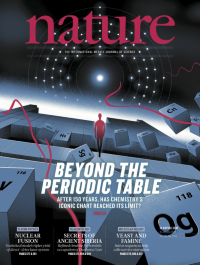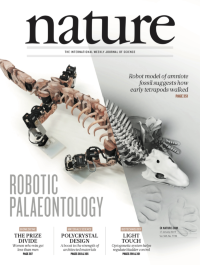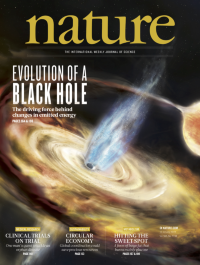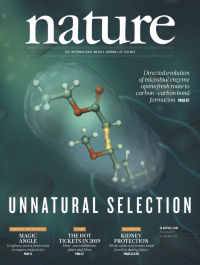Volume 565
-
No. 7741 31 January 2019
Beyond the periodic tableA ubiquitous sight in chemistry labs and classrooms around the world, the periodic table of elements celebrates its 150th birthday this year. When Dmitri Mendeleev published his first draft of the table in 1869, only 63 elements were known to science. Now there are 118. This week’s issue examines the past, present and future of the iconic chart — from the history of atomic ideas that pre-dated Mendeleev, to the difficulties researchers face in extending the table any further. The true organizational principle behind this arrangement of the elements is probed, as is its impact beyond the confines of science. Whatever the future may hold for the drive to create new superheavy elements, there is little doubt that efforts to explore the properties of elements will continue — a quest that owes a huge debt to Mendeleev and may ultimately take us beyond the periodic table.
-
No. 7740 24 January 2019
The rise of the AndesThe extensive chain of mountains that makes up the Andes was formed as the result of the Nazca tectonic plate under the Pacific Ocean being driven against and below continental South America. In this week’s issue, Yi-Wei Chen and his colleagues use a seismic tomography model to reconstruct the history of subduction along this margin, offering a fresh perspective on the link between mountain formation and plate subduction. The researchers find that current phase of Nazca subduction began in the northern Andes around 80 million years ago and propagated southwards, reaching the southern Andes around 55 million years ago. This suggests that, contrary to popular belief, Nazca subduction was not a continuous process but has instead occurred in episodic phases. They also find that the start of the compression that formed the Andes was linked to interaction between the Nazca slab and the lower mantle, which is consistent with some earlier models.
-
No. 7739 17 January 2019
Robotic palaeontologyExactly how the gait of four-legged vertebrates evolved when they first ventured on to land has proved difficult to decipher because of the often-limited amount of information preserved in the fossil record. In this week’s issue, John Nyakatura and his colleagues present a reverse-engineered reconstruction of how the stem amniote Orobates pabsti probably moved. This particular species lends itself to such a treatment as a complete fossil exists along with fossilized trackways that capture where it placed its feet as it walked. The researchers digitized both the fossil and the trackway before creating kinematic and dynamic simulations to identify plausible gaits. They then built a working robotic model of Orobates to validate their work. The results suggest that Orobates had more advanced locomotion — more upright, balanced and mechanically power-saving — than had previously been assumed for early tetrapods, suggesting that advanced locomotion might have preceded the diversification of amniotes.
Spotlight
-
No. 7738 10 January 2019
Evolution of a black holeThe cover image shows an artist’s impression of a black hole that has started to accrete material from a nearby star. The properties of accretion flow for a stellar-mass black hole can change on a timescale of days to months. When the black hole ‘turns on’ after accreting material it has a hard (high-energy) X-ray spectrum that is produced by the hot corona (shown in blue) above its accretion disk (yellow). It then changes to a soft (lower-energy) spectrum that is dominated by emissions from the accretion disk. But whether it is a change in disk’s radius or a reduction in the corona that drives this transition has been an open question. In this week’s issue, Erin Kara and her colleagues provide results that may help to settle the debate. The researchers studied a newly identified black hole transient and followed its evolution using instruments on the International Space Station. They found over the course of the hole’s evolution from hard to soft emissions, the corona contracts but the inner edge of the accretion disk stays in the same place.
-
No. 7737 3 January 2019
Unnatural selectionThe catalytic replacement of a carbon–hydrogen bond with a carbon–carbon bond is an attractive strategy for building organic molecules. In this week’s issue, Frances Arnold and her colleagues report that a cytochrome P450 enzyme can be evolved to perform this transformation efficiently within bacteria. Their iron-haem enzymes catalyse carbene insertion into sp3 hybridized C–H bonds, and deliver alkylated products with high enantioselectivity. The team’s results highlight that iron can be used to achieve this challenging reaction, indicating that this metal could replace less abundant elements, such as rhodium and iridium, that have previously been used for such functionalization. Although nature’s chemical repertoire does not include carbene C–H insertion, an existing enzyme produced within a microbe can be modified to perform these abiological reactions.





